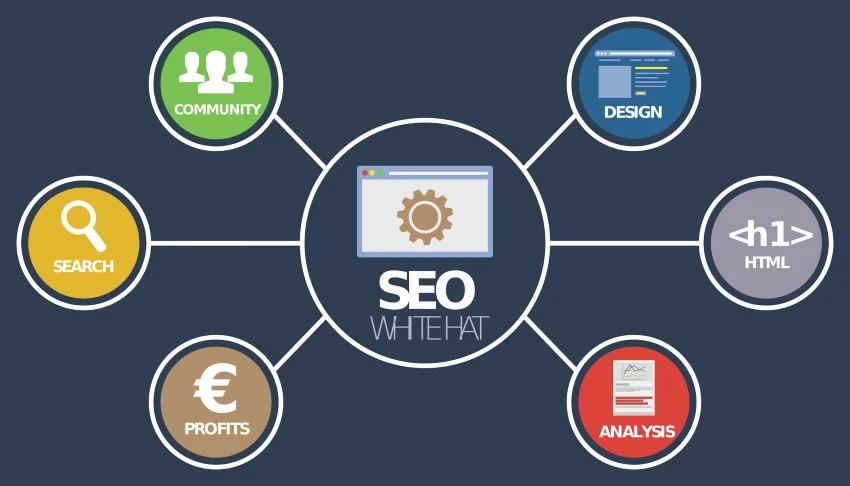When doing digital marketing, mastering the art of navigating algorithmic changes in digital landscapes for adaptive SEO is the linchpin to securing and sustaining online success. As search engine algorithms continually evolve, staying ahead of the curve and adapting your SEO strategies is imperative. So, let’s cover the strategies and insights that can empower you to thrive amidst the ever-changing digital terrain!
Understanding algorithmic changes
Understanding algorithmic changes is pivotal in the world of digital marketing and SEO. Search engine algorithms, like Google’s, are constantly evolving to deliver more relevant and user-friendly results to searchers. These algorithms take into account a multitude of factors, such as content quality, backlinks, and user experience. So, you need to master it to improve your advertising and level up your brand.
To stay ahead, keeping a vigilant eye on algorithm updates is crucial. These updates can significantly impact your website’s visibility and ranking on search engine results pages (SERPs). For instance, Google’s BERT update focused on understanding the context of search queries, emphasizing the importance of matching user intent.
In essence, grasping algorithmic changes is not an option but necessary in the ever-evolving digital landscape. Adapting your SEO strategy to align with these changes is the surefire way to secure a competitive edge.

Navigating algorithmic changes: Impact of algorithmic changes on SEO
The impact of algorithmic changes on SEO cannot be overstated. These changes, often implemented by major search engines like Google, dictate how websites are ranked and displayed in search results.
When algorithms are updated, the rankings of websites can fluctuate dramatically, affecting their visibility to potential visitors. That, in turn, can have significant consequences for businesses and online brands, as organic search traffic is a cornerstone of many digital marketing strategies.
Staying informed about these changes is essential for SEO professionals because it enables them to adapt their strategies accordingly. For instance, updates like Core Web Vitals have made user experience and website performance critical ranking factors, requiring website owners to optimize their sites for speed and mobile-friendliness. So, algorithmic changes wield substantial influence over the SEO landscape. Also, staying ahead of these changes is paramount for anyone looking to maintain or improve their online visibility and digital presence.

The adaptive mindset
The adaptive mindset is the cornerstone of navigating algorithmic changes. To thrive in SEO, professionals must embrace a flexible mindset and an eagerness to improve.
Recognizing that algorithms are in perpetual flux, experts understand that what works today may not be effective tomorrow. This proactive approach allows them to view algorithmic changes as opportunities for growth rather than obstacles.
By continually monitoring shifts in search engine algorithms and keeping pace with industry trends, SEO practitioners can fine-tune their strategies to align with the latest developments. That includes staying informed about updates like BERT and Core Web Vitals, which we already mentioned.
An adaptive mindset also encourages professionals to experiment with new techniques and technologies, such as optimizing for voice search and exploring emerging platforms. So, the adaptive mindset is a fundamental trait that enables you to survive and thrive doing digital marketing. It empowers them to handle changes confidently, seize new opportunities, and consistently deliver outstanding results for their brands and clients.
Monitoring algorithm updates
Monitoring algorithm updates is a fundamental practice for navigating algorithmic changes. Staying vigilant and well-informed about changes in search engine algorithms, such as Google’s updates, ensures that websites can adapt effectively.
Using various SEO tools, professionals can track these updates and their impact on search rankings, organic traffic, and user engagement. Setting up alerts and notifications for algorithm changes is also essential, as it allows for timely strategy adjustments.
Analyzing data trends post-update is crucial in comprehending how changes have influenced website performance. With this data-driven approach, experts can make optimal decisions and proactively optimize their websites to align with evolving algorithms.
Moreover, understanding the specific changes within each algorithm update is vital. So, monitoring algorithm updates is not a one-time task but an ongoing commitment. It equips professionals with the knowledge and tools to adapt to the ever-shifting SEO requirements, ensuring websites remain competitive.
Content optimization for algorithmic changes
Content optimization in response to navigating algorithmic changes is a crucial aspect of an effective SEO strategy. In a landscape where algorithms like Google’s are continually evolving, it’s essential to adapt your content to align with these changes.
Today’s emphasis is on producing high-quality, relevant content that matches user intent. That means understanding the needs and expectations of your target audience and crafting content that addresses those requirements comprehensively.
So, even if you plan to use user-generated content in your marketing strategy, this still applies. After all, this ensures that user-generated content is valuable and relevant to your audience.
In addition, optimizing for features like voice search and featured snippets has gained prominence, demanding a shift in content creation toward providing concise and informative answers to queries.
Adapting to these shifts by enhancing your content strategy ensures your website remains visible, competitive, and valuable. As such, content optimization for algorithmic changes is the linchpin of success.
Technical SEO for algorithm changes
Technical SEO is a fundamental pillar for adapting to algorithm changes effectively in the dynamic digital ecosystem. These changes, such as Google’s updates, often place a strong emphasis on technical aspects.
Mobile-friendliness, for instance, has become a crucial ranking factor, given the surge in mobile device usage. Websites must also be responsive, ensuring a seamless experience across different screen sizes. Furthermore, page speed optimization plays a pivotal role in rankings. Slow-loading pages can result in a poor experience, driving visitors away and affecting your search visibility negatively. Properly optimizing images, leveraging browser caching, and minimizing HTTP requests are key steps in enhancing website performance!
Schema markup and structured data are equally vital in technical SEO. Implementing structured data helps search engines better understand your content, potentially leading to rich snippets, which can boost click-through rates. So, it’s crucial to stay updated on algorithmic changes that focus on these technical factors, such as Core Web Vitals, and to continuously refine your website’s technical aspects accordingly.
Essentially, technical SEO is not just a checkbox. It’s an ongoing process that ensures your website is well-prepared for changes and user expectations.

Link-building strategies
Link-building strategies are essential in the realm of SEO, shaping the credibility and authority of your website. Building high-quality backlinks from authoritative and relevant sources remains a cornerstone. However, it’s crucial to avoid black-hat practices like link farms and link spam, which can lead to penalties.
Link diversity is another key aspect. A diverse backlink profile consisting of various links (e.g., guest posts, social shares, directory submissions) enhances your website’s trustworthiness. Building relationships with influencers and other websites in your niche can further lead to valuable opportunities for collaboration and link-building.
At the same time, internal linking is often overlooked but holds significant value. Strategically linking relevant pages within your site helps search engines understand the hierarchy and importance of your content.
User-generated content can also be a valuable resource for link building, as it can generate organic backlinks when users share their contributions on social media or other platforms. Monitoring and analyzing your backlink profile is, therefore, crucial to identify and disavow any toxic or spammy links that might harm your site’s reputation.
In a nutshell, effective link-building strategies encompass a holistic approach, combining ethical practices, diversity, and relevance. By building and maintaining a healthy backlink profile, you can enhance your website’s authority, improve rankings, and ultimately drive more organic traffic to your site.
Navigating algorithmic changes: User experience and algorithm changes
User experience (UX) and algorithm change share an intricate relationship. Search engines, like Google, increasingly prioritize websites that offer exceptional experiences. This emphasis has become especially pronounced with algorithm updates like the already covered Core Web Vitals.
To excel in this landscape, website owners must design and optimize their sites with user-centricity in mind.
Moreover, focusing on user intent and crafting content that effectively satisfies search queries aligns with algorithmic changes like BERT. So, it’s essential to understand the questions users are asking and provide comprehensive answers through your content.
User-friendly design, clear navigation, and a well-structured layout contribute to a positive UX. Elements like easy-to-find contact information and well-organized menus also enhance user satisfaction and can lead to better search engine rankings.
As such, the intersection of UX and algorithm changes underscores the importance of delivering seamless, valuable experiences to website visitors. Prioritizing experience not only aligns with the latest SEO requirements but also enhances engagement, resulting in improved rankings and sustained success.
Local SEO in a changing landscape
Local SEO is paramount in a landscape where consumers increasingly rely on search engines to find local businesses. Still, the changing SEO environment brings new challenges and opportunities for businesses aiming to strengthen their local presence. For example, optimizing for Google My Business is a fundamental step, ensuring your business information is accurate and up-to-date.
Not to mention that local businesses must navigate algorithmic changes, such as updates affecting the importance of online reviews. Encouraging satisfied customers to leave reviews can enhance your local visibility and reputation.
Voice search is another emerging trend in local SEO, as people use voice-activated devices to find nearby services. So, optimizing your content for voice queries can give you an edge in local search rankings.
Local SEO strategies must also consider regional algorithmic changes and adapt accordingly. Comprehending the nuances of your local market can help you tailor your efforts to it.
Therefore, local SEO in a changing landscape demands adaptability and a keen understanding of evolving algorithms and consumer behavior. By staying informed about the best practices and embracing changes as opportunities, businesses can boost their online visibility, attract more local customers, and thrive.
E-commerce SEO strategies
E-commerce SEO strategies play a pivotal role in the success of online businesses, especially in today’s competitive digital marketplace. The evolving SEO landscape presents unique challenges and opportunities for e-commerce sites. Firstly, optimizing product pages is paramount, including keyword research and placement and crafting compelling product descriptions.
Leveraging user-generated content can also be a powerful strategy, as reviews and testimonials not only boost credibility but can also generate valuable, user-generated keywords. Implementing structured data and schema markup further helps search engines understand your product information, which boosts your visibility.
In addition, optimizing for long-tail and voice search queries is increasingly important. So, tailoring your content and product listings to align with these trends can give you a competitive edge.
As is obvious, e-commerce SEO strategies must evolve alongside changing algorithms and consumer behavior. A holistic approach is essential for e-commerce sites looking to thrive in the dynamic digital marketplace.
International SEO considerations
International SEO considerations are crucial for businesses expanding their online presence globally. Going beyond borders requires a nuanced approach that respects linguistic and cultural differences. One must handle multilingual SEO challenges adeptly, ensuring that content translation exceeds mere language accuracy and captures local idioms and cultural nuances.
Adapting to regional algorithmic changes is essential, as search engines may prioritize certain factors differently in various regions. Optimizing for local search queries and using geolocation data effectively can help you connect with local audiences.
Hreflang tags play a pivotal role in international SEO, signaling to search engines which language and region-specific webpage versions to display to users. Proper implementation prevents issues like duplicate content and ensures users land on the most relevant page.
Lastly, international SEO must consider technical aspects like server location, website hosting, and page load times. A content delivery network (CDN) can help deliver content quickly to users across different geographic locations, improving user experience.
So, international SEO is a complex but necessary endeavor for businesses expanding their global footprint. Navigating linguistic and cultural differences, optimizing for local search, and staying informed about regional algorithmic changes are all essential components of a successful international SEO strategy!
Algorithmic changes and social media
Algorithmic changes in social media platforms have a significant impact on your digital marketing efforts. Platforms like Facebook, Twitter, and Instagram constantly refine their algorithms to deliver more relevant content to users. As a result, organic reach can fluctuate, affecting your content’s visibility. That is something you need to pay close attention to, especially if you’re planning to embrace affiliate marketing.
Algorithm updates often prioritize posts from friends and family over branded content, making it crucial to create engaging and shareable content that resonates with your target audience. Also, keeping an eye on metrics like engagement rates and click-through rates can provide insights into how your content is performing under the current algorithm.
On top of that, social media algorithms consider factors like the time your content is posted and the frequency of your posts. So, consistency and strategic scheduling are essential to maximize your content’s visibility.
Incorporating user-generated content and encouraging social interactions can also help improve your organic reach. Building a strong community around your brand can lead to more authentic and valuable interactions!
As such, staying informed about algorithmic changes on social media platforms and adapting your strategy is vital for successful digital marketing. By understanding how these changes affect your content’s reach and engagement, you can refine your approach and navigate algorithmic changes with confidence.
Future-proofing your SEO strategy
Future-proofing your SEO strategy is essential in a constantly evolving digital landscape. With search engine algorithms and user behaviors continually changing, it’s crucial to build a resilient strategy that can adapt to emerging trends. Start by staying updated on algorithm updates and industry best practices to ensure your tactics remain effective.
Embrace the importance of user experience (UX) as it becomes a prominent ranking factor, too. Prioritize mobile-friendliness, fast-loading pages, and user-friendly navigation at all times. Core Web Vitals are now integral to SEO, so they will unlikely fall out of favor.
Voice search, too, is unlikely to fall out of use, and incorporating voice-friendly content and schema markup is becoming increasingly important. Meanwhile, consider the impact of artificial intelligence and machine learning on SEO. These technologies are shaping the way search engines understand and rank content.
Furthermore, diversify your content strategy by exploring videos, podcasts, and interactive content. Visual and auditory formats are gaining popularity, and including them in your strategy can help you reach a broader audience.
Lastly, foster a holistic approach by combining SEO with other digital marketing tactics such as content marketing, social media, and email marketing. A synergistic approach ensures you’re not reliant solely on one channel.
As such, future-proofing your SEO strategy involves constant learning, adaptation, and innovation. By staying ahead of the curve and embracing emerging trends, you can position your website for sustained success in the long term.
For the true SEO excellence
In the ever-evolving digital arena, mastering the art of navigating algorithmic changes in digital landscapes for adaptive SEO is an ongoing journey. With a proactive mindset, a holistic approach, and a commitment to staying informed, you can position yourself for long-term success. So, as algorithms shift, remember that adaptability and innovation are your allies on the path to SEO excellence!
About the Author

Meet Maximilian Covington, a seasoned SEO and conversion specialist passionate about optimizing online experiences. With a wealth of expertise acquired through years of dedication, Maximilian currently serves as a key asset at Convert More, where he leverages his unique insights to drive digital transformations that maximize conversions and elevate user engagement.


